 Dell recently announced that it has expanded FX2 architecture to include two new server blocks and a new storage block. At its launch, and in our initial review, the FX2 had FC630 and FM120x4 compute blocks. This time we will be taking a closer look at the new FD332 storage block and the FC830 server block. The FD332 gives users the ability to uniquely add storage density by pulling the sled out and adding drives to its side. The FC830 enables users to have up to 8 cores in a single 2U enclosure.
Dell recently announced that it has expanded FX2 architecture to include two new server blocks and a new storage block. At its launch, and in our initial review, the FX2 had FC630 and FM120x4 compute blocks. This time we will be taking a closer look at the new FD332 storage block and the FC830 server block. The FD332 gives users the ability to uniquely add storage density by pulling the sled out and adding drives to its side. The FC830 enables users to have up to 8 cores in a single 2U enclosure.
Dell recently announced that it has expanded FX2 architecture to include two new server blocks and a new storage block. At its launch, and in our initial review, the FX2 had FC630 and FM120x4 compute blocks. This time we will be taking a closer look at the new FD332 storage block and the FC830 server block. The FD332 gives users the ability to uniquely add storage density by pulling the sled out and adding drives to its side. The FC830 enables users to have up to 8 cores in a single 2U enclosure.
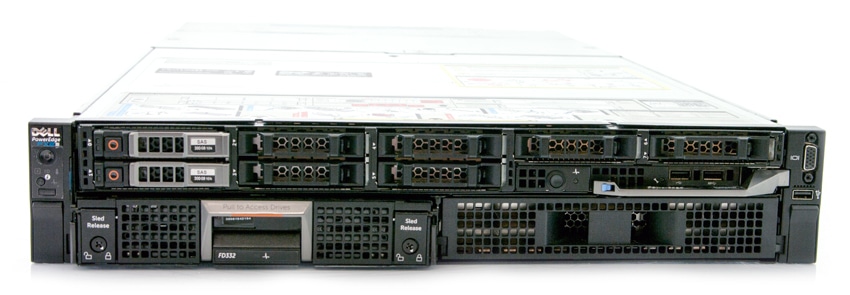
The Dell PowerEdge FD332 is a dense, blade style storage block. The FD332 is half-width allowing for up to four in one FX2 enclosure (though one would need to add at least one half-width block for compute such as the PowerEdge FC630). Each FD332 holds up to 16 small form factor drives for direct attached storage, which could give users up to 48 SFF drives in one FX2 enclosure (again leaving a half-width section for compute). The FD332 drives are hot-pluggable and support both SAS and SATA and HDD and SSD. Servers can be attached to one or multiple FD332 blocks and can also attach to all 16 drives or, using a RAID controller, access can be split between 8 drives. This high level of flexibility makes it suitable for various IT applications from traditional to high-performance low-cost, scale-out and scale-up operations.
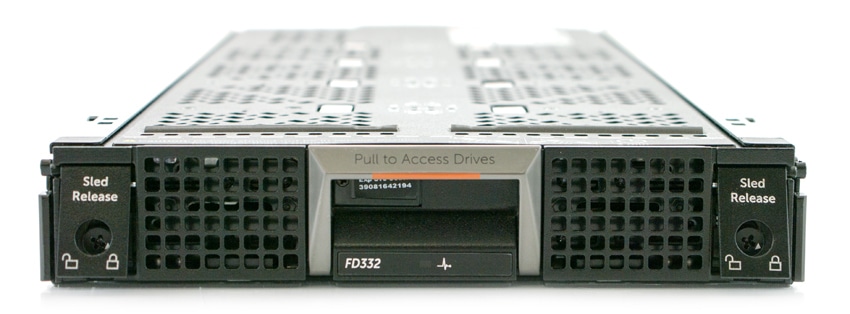
The Dell PowerEdge FC830 is a full width, blade-style, dense, scale-up server block. The FC830 supports up to four E5-4600 v3 Intel Xeon processors and up to 1.5TB of DDR4 memory making it ideal for a wide range of applications and virtualized environments. The FC830 also has either 8 2.5” or 16 1.8” drives and can access up to 8 PCIe expansion slots. These capabilities also make it a good candidate for high demand, mission critical workloads such as database driven, centralized business applications, CRM, ERP, and HPC environments.

Of course, this combination is just one of several possible to be used in the PowerEdge FX2 enclosure, which is one of the main benefits/selling points. The FX2 architecture comes with a 3-year warranty and price will vary depending on combination.
Dell PowerEdge FX2 Specifications
- Form factor: 2U chassis
- Dimensions:
- H: 8.68cm (3.4in)
- W: 43.35cm (17.06in) without rack ears; 48.19cm (18.97in) with rack ears
- D: 85.16cm (33.52in)
- Server block options: Up to 4 half-width Dell PowerEdge FC630 servers or PowerEdge FM120x4
- Power supplies: 1600W or 1100W AC hot plug in 1+1 redundant or 2+0 non-redundant configurations
- Cooling: 8 hot-swappable fans provide cooling to the I/O components in the system
- Communications: Up to 2 pass-through modules, 1Gb and 10Gb capable
- I/O slots: Up to 8 x PCIe 3.0 expansion slots (low profile/half-length)
- Systems management:
- Chassis Management Controller (CMC) to manage all resources (server nodes and shared infrastructure) in a single web console
- OpenManage portfolio for FX supports local and remote management consistent with other PowerEdge products
- CMC and iDRAC are available with either Enterprise or Express licensing
- Redundant CMC module is available
- Server nodes each contain iDRAC8 with Lifecycle Controller for agent-free, automated systems management
FD332 specifications:
- Storage: 16 x Small Form Factor Drives (SSD or HDD, SATA or SAS)
- RAID Controllers: Internal controllers:
- FD33xS (single PERC)
- FD33xD (dual PERC)
- Remote management:
- iDRAC8 Express with Lifecycle Controller (default)
- iDRAC8 Enterprise with Lifecycle Controller (upgrade option)
- System management:
- FX uses Chassis Management Controller (CMC) to manage all resources (server nodes and shared infrastructure) in a single web console
- OpenManage portfolio for FX supports local and remote management, consistent with other PowerEdge products
- CMC and iDRAC are available with either Enterprise or Express licensing to best suit specific management needs
- Server nodes each contain proven iDRAC8 with Lifecycle Controller for agent-free, automated systems management
- Power: 1600W in 1+1 redundant or 2+0 non-redundant configurations
- Chassis: Form factor: Half-width
- Dimensions (HxWxD): 1.58 x 8.32 x 20.43 in (40.15 x 211.9 x 518.8 mm)
- Up to 3 FD332 storage blocks per PowerEdge FX2 chassis (configuration dependent)
FC830 specifications:
- Form factor: Full-width – supports up to 2 sleds per PowerEdge FX2 enclosure
- Processor:
- Intel Xeon processor E5-4600 v3 product family
- Processor sockets: 4
- Cache: 2.5MB per core; core options: 4, 6, 8, 10, 12, 16, 18
- Chipset: Intel C610 series
- Memory: Up to 1.5TB (48 DIMM slots): 4GB/8GB/16GB/32GB DDR4 up to 2133MT/ss
- I/O mezzanine cards: Access to 4 x PCIe 3.0 (x8) expansion slots, (up to 8 for certain configurations)
- RAID controllers: Internal controllers: PERC S130 (SW RAID), PERC H330, PERC H730, PERC H730P
- Storage:
- PowerEdge Express Flash NVMe PCIe
- SATA HDD/SSD
- SAS HDD/SSD
- Up to 16 x 1.8” SSD or 8 x 2.5”
- Optional adapters: Optional NICs and HBAs
- Power supplies: Chassis level – PowerEdge FX2 hot-plug PSU: 2000W or 1600W AC in 1+1 redundant or 2+0 non- redundant configurations
- Video card:
- Video type Matrox G200 (integrated with iDRAC8)
- Video memory: 16MB shared with iDRAC8 application memory
- Dimensions (HxWxD): 1.58 x 4.04 x 18.89 in (4.03 x 1.03 x 5480 cm)
- Systems management:
- FX uses Chassis Management Controller (CMC) to manage all resources (server nodes and shared infrastructure) in a single web console
- OpenManage portfolio for FX supports local and remote management, consistent with other PowerEdge products
- CMC and iDRAC are available with either Enterprise or Express licensing to best suit specific management needs
- Server nodes each contain proven iDRAC8 with Lifecycle Controller for agent-free, automated systems management
- Operating systems:
- Microsoft Windows Server 2008 R2
- Microsoft Windows Server 2012
- Microsoft Windows Server 2012 R2
- Microsoft Windows HPC Server 2008
- Novell SUSE Linux Enterprise Server
- Red Hat Enterprise Linux
- VMware ESX
Design and Build
The PowerEdge FX2 enclosure comes in an industry standard 2U rackmount form factor. The FX2 chassis will support four half-width, eight quarter-width sleds or two full width sleds. The front of the FX2 chassis provides on-site KVM access with a VGA port and USB connectivity. A KVM switch on the front allows users to toggle which sled is routed through the front-mount ports.

The FX2 features two 1100W or 1600W hot-plug power supplies that can be used in a redundant failover configuration or in tandem to handle greater power requirements. The PowerEdge FX2 also incorporates up to two pass-through Ethernet modules with 1GbE or 10GbE connectivity that can be replaced by the FN IO Aggregator block to reduce cable clutter, provide alternate fabric connectivity, and increase network communication performance between installed blocks. Some FX2 chassis configurations also feature eight low-profile/half-length PCIe 3 expansion slots that can be assigned and reassigned to installed server and storage blocks.
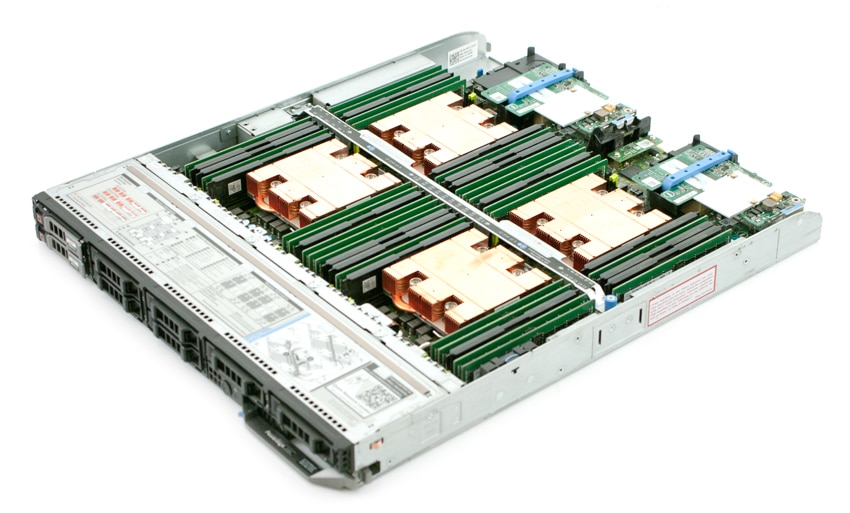
While each compute node installed in the FX2 chassis supports some amount of onboard storage, there will always be customers that need additional capacity for certain applications. To address this segment of the market, Dell introduced the PowerEdge FD332 storage node. The PowerEdge FD332 is a half-width block that installs into one half-width slot on the FX2. The front of the block has a handle in the middle, ventilation on both sides, and two locks to prevent accidentally opening while in use. The drive mounting arrangement is fairly inventive given the small space Dell had to work with. Each drive slot-loads into the right or left side of the long pull-out tray, holding up to 16 2.5″ disks. Removal is simple as well; simply pull the block out, press a button on the top (above the drive you wish to access), a handle will pop out of the side, and users can pull the drives out.
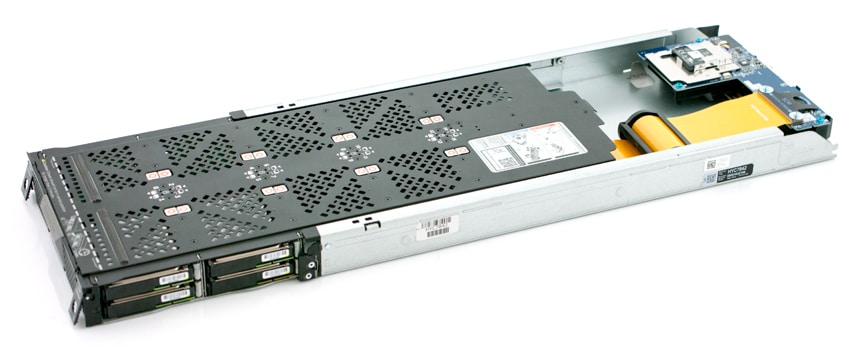
While the FC830 was originally announced at the launch of the FX2 portfolio, details on the exact hardware were slim. The PowerEdge FC830 is a full-width block and also can be pulled out of the front of the FX2 chassis. The main draw of course is that the roughly 1U shaped node supports four Intel Xeon E4-4600 v3 CPUs and up to 1.5TB of memory. Onboard storage can be configured to support 8 2.5″ disks or 16 1.8″ SSDs (as well as NVMe storage).
Management
A huge strength of the PowerEdge FX architecture is that it offers customers two management options. PowerEdge FX administrators can take advantage of Dell’s OpenManage systems management portfolio including the company’s agentless iDRAC with Lifecycle Controller, or they can leverage the embedded Chassis Management Controller (CMC).
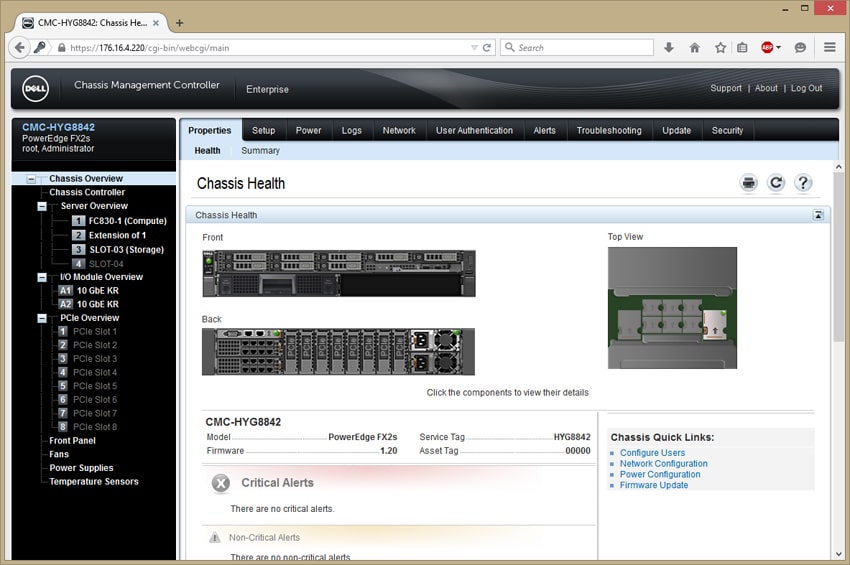
iDRAC8 provides administrators with a rackserver management paradigm that includes local and remote access, while the CMC offers the ability to manage the servers and chassis collectively in a one-to-many blade server management paradigm. CMC uses a browser-based GUI with a paralleled layout and design to iDRAC’s management interface which helps simplify the learning curve.
The iDRAC Direct feature allows administrators to use a USB key to deploy hardware configurations to 13G PowerEdge servers, including BIOS, iDRAC, PERC, and NIC settings. iDRAC Direct also allows administrators to access the iDRAC management GUI via a laptop connected to the server via a USB cable. A new iDRAC Quick Sync capability allows administrators with Android-powered mobile devices to touch optional iDRAC Quick Sync hardware in the front bezel of a 13G PowerEdge server to view server status and logs.
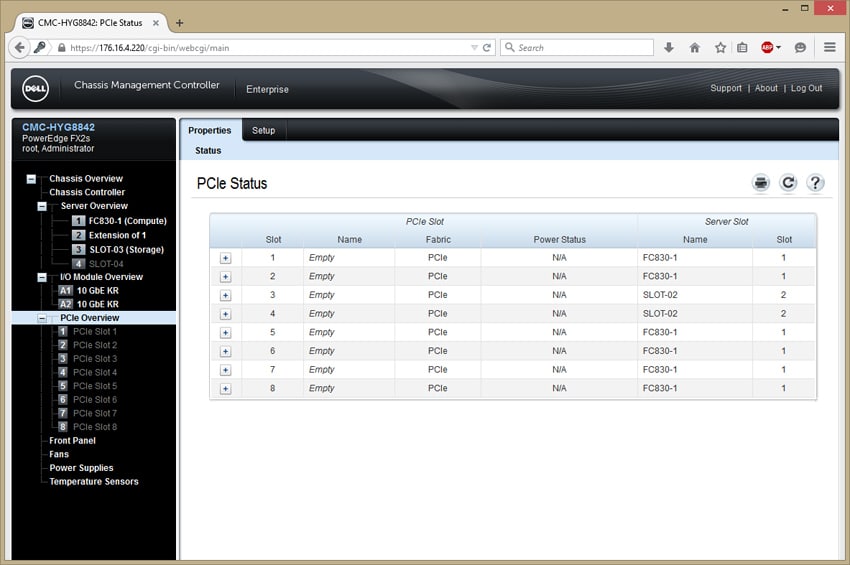
Through the CMC, users can drill down into the iDRAC8 interface for each server block. From a central management perspective it’s incredibly nice to be able to chunk in a new compute node and assign its iDRAC settings through the FX2’s CMC, instead of worrying about finding it on DHCP or a preset static IP from the factory.
Conclusion
As we previously stated, the PowerEdge FX2 is Dell’s new next-gen converged infrastructure that consolidates the density and efficiency of blade-based architecture within a 2U rack form factor, maintaining the simplicity and cost benefits of a rack-based system. The PowerEdge FD332 storage block enables users to add up to 48 SSF drives (either SAS or SATA, HDD or SSD) to a single FX2 enclosure. The FD332 is highly flexible making it a good fit anywhere in the spectrum of use from traditional to cutting-edge. The PowerEdge FC830 server carries four high-performance processors and a tremendous amount of memory in a ridiculously small body. The FC830s can also support either 8 2.5” drives or 16 1.8” drives. The FC830 is powerful enough for high-demand mission critical workloads such as large-scale virtualization or the database tier of WebTech and HPC environments.
These new additions to the FX2 line add in a few unique benefits. As we have stated in previous mention of the FX2 line, it supports various sleds that make up different aspects of customers’ overall infrastructure. With the FD332, customers can start off small and add new blocks as needed (up to 48 drives with a half-width compute block or 32 drives with a very powerful server such as the FC830). One benefit of the FD332 is that the surface area of the front of the device doesn’t limit the drive bays. Instead, drawers pull out and the drives are populated on the side of each drawer. This gives an overall high density in a 2U space. The FC830 also is all about density but from a compute side. The FC830 offers four high-performance processors in a 1U space, as opposed to other offerings that are much larger. Not only that, in the same space users can have up to 1.5TB of memory and 16 drives for storage. In one FX2 chassis, two FC830 can be added in and running. So in a 2U space, one could potentially have 8 high-performance processors, 3TB of memory, and 32 drives for storage. There are very few ways to get to these levels of density, this enhancement again illustrate Dell’s impressive engineering prowess.
Dell’s PowerEdge FX2 platform is growing into a very compelling offering, blending traditional rack-mount form factors with an ever-growing array of converged compute, storage and networking options. For growing enterprise applications, users can now pick from a wide range of mid-range to high-performance server nodes and add in storage blocks for additional local storage capacity. Few other options exist on the market today that can address the same market segments, pushing Dell into a market leadership position for ultra-dense converged infrastructure offerings.
The Bottom Line
The Dell PowerEdge FX2 with the FD332 and FC830 provides enough storage and power to process workloads from traditional applications like database and virtualization to the most cutting-edge transactional workloads, while giving customers the flexibility to scale and change as needed.
Sign up for the StorageReview newsletter
